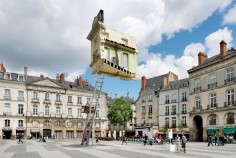LEANDRO ERLICH
Леандро Эрлих
莱安德罗·埃利希
Le Monte-Meubles, l’Ultime Déménagement

source: highlike
Work: In his piece “The Furniture Lift – the Ultimate Moving out”, Argentine artist Leandro Erlich imagined an impossible situation: a furniture lift leaning against a window, which is the only part remaining of a building… and floating in the air. The piece turns a common event into a perturbing spectacle. It invites us to reflect about a double impossibility, at the time contradictory and vital: if human being can’t resist some dramatic situations, yet he resists them.
Leandro Erlich, Monte-meubles – l’ultime déménagement, Place du Bouffay, Nantes, dans le cadre du Voyage à Nantes 2012, France.
Photographer: Martin Argyroglo
.
.
.
.
.
.
.
source: itsnicethat
You might remember Argentinian artist Leandro Erlich from his spectacular installation Dalston House earlier in the year, where visitors hung from windows, skated window sills and scaled the facade of a house that laid horizontally in front of the foundations of a Victorian house destroyed by bombing in the Second World War. Or perhaps you know him for his illusory corridors, lift shafts or his swimming pool galleries where art-goers are permanently submerged beneath the surface.
So perhaps this work will be less of a surprise, but if you can resist gawping at this next installation, nothing will impress you. Taking the centre square of Nantes, France as his exhibition space, Leandro has moved in Monte-meubles – L’ultime déménagement, The Furniture Lift. This extraordinary work is yet one more illusion to add to the collection, seeing the corner of a room suspended as though having abandoned the rest of its house with brickwork revealed and floorboards gaping at the joists. Created for the biannual Le Voyage a Nantes that sees the entire city of Nantes transformed into an art gallery, Leandro’s installation stood an terrifying 30 feet high, supported by a ladder alone. Appearing to float independently, let’s go with superstition and say that is one ladder you definitely would not want to walk underneath but admire, from a comfortable distance.
.
.
.
.
.
.
.
source: skny
Leandro Erlich was born in Buenos Aires, Argentina, in 1973. An architect of the uncertain, Erlich creates spaces with fluid and unstable boundaries. Before one tries to make sense of his sculptures and installations, one senses the uncanny. A single change (up is down, inside is out) can be enough to upset the seemingly normal situation, collapsing and exposing our reality as counterfeit. Through this transgression of limits, the artist undermines certain absolutes and the institutions that reinforce them.
Leandro Erlich draws inspiration from his literary Argentinian forebear, Jorge Luis Borges, but references to the world of film also appear frequently in his work; Erlich makes no secret of his admiration for directors like Alfred Hitchcock, Roman Polanski, Luis Buñel and David Lynch, whom, he argues, “have used the everyday as a stage for creating a fictional world obtained through the psychological subversion of everyday spaces.”
Between 1998 and 1999, Erlich took part in the Core Program, an artist residency at the MFA in Houston, and came to the attention of the art world at a young age. In 2001 he was invited to represent his country in the 49th Venice Biennale. He then participated in the Biennials of Istanbul (2001), Shanghai (2002) and São Paulo (2004). He has also participated in the Whitney Biennial (2000) and the 1st Busan Biennale, Korea (2002). He was part of La Nuit Blanche de Paris (2004), the 51st Venice Biennale (2005), the Echigo-Tsumari Art Triennial, Japan (2006), and the exhibition Notre histoire at the Palais de Tokyo, Paris, in 2006, among others. In 2008, his installation La Torre was exhibited at Museo Reina Sofia, Madrid, and he showed his acclaimed Swimming Pool at MoMA P.S. 1 the same year.
Erlich’s works are included in several private and public collections including the Museum of Modern Art, Buenos Aires; The Museum of Fine Arts, Houston; Tate Modern, London; Musée d’Art Moderne, Paris; 21st Century Museum of Contemporary Art, Kanazawa, Japan; MACRO, Rome; The Israel Museum, Jerusalem; and the Fonds National d’Art Contemporain (FNAC), Paris.
Erlich lives and works in Paris, France, and Buenos Aires, Argentina.
.
.
.
.
.
.
.
source: okayquitmadstopblogspot
Leandro Erlich is an Argentinian artist living and working between Argentina and Paris. His works mainly focus on familiar architectural elements and the audience’s perception of reality. The experience requires the viewer to go beyond the allure of the visual marvels and to explore their own psychological reality by stepping into Erlich’s world of illusion, reflection and reversal. His temporary exhibition is running in Long Beach, California at the moment and his piece “Swimming Pool” is permanently installed at the Kanazawa Museum, Japan. Hopefully I’ll get the opportunity to experience his pieces in person at some point! I hope you like his work, and please visit his website for more photos and information here.
.
.
.
.
.
.
.
.
source: revistacasaejardimglobo
Uma casa em Nantes, na França, parece ignorar a lei da gravidade. Ela flutua tranquilamente a 9 metros de altura sobre a praça central e atrai olhares curiosos de todos que passam. Uma escada convida os visitantes a subir na simpática construção. Seria um milagre? O artista argentino Leandro Erlich, responsável pela montagem, revela o truque: a estrutura é, na verdade, sustentada pela escada. A instalação de arte surreal faz parte do festival Art Journey e foi batizada de Monte Furniture.
Apesar de ter sido feita especialmente para a exposição, a construção parece ser um fragmento arrancado de uma casa já existente, exibindo pedaços de tijolos e madeira. As janelas têm o charmoso estilo parisiense, o que deixa a cena ainda mais parecida com um sonho. É inacreditável pensar que tudo aquilo mantenha o equilíbrio no ar somente com o apoio da escada, mas a composição é possível, pois ela funciona como uma coluna, que garante a estabilidade. Outro segredo: a casa foi feita com materiais mais leves do que os comuns.
.
.
.
.
.
.
.
source: alldayplusru
Leandro Erlich/Леандро Эрлих (род. в 1973, Буэнос-Айрес, Аргентина) – один из самых изобретательных и инновационных художников на современной международной художественной сцене. Он создает уникальные инсталляции, которые бросают вызов законам физики , нарушая привычное ощущение равновесия и пространства, и переворачивают наше восприятие реального мира. Его работы – это дезорганизующие, неожиданные и весёлые визуальные иллюзии.
.
.
.
.
.
.
.
source: blogsinacomcn
艺术之词,常常让人觉得敬而远之。谁人都懂发音的二字,看似容易理解,实则却抽象非常。其实何谓艺术对于大多数如笔者一般的普通人都甚难理解和接触的。特别又如中国当代艺术,普罗大众更多的是作为“噢!中国当代艺术大师XXX作品拍卖X千万”之类新闻的看客,并把之作为饭后同事闲聊的谈资,甚至艺术品就是等于“千万高价”,但艺术真为此物吗?固然不是,可又有谁能用最通俗易懂的方式去让人们“理解”艺术呢?
虽然中国已经冒出无数之画廊、艺馆,又有庞大之媒体力量热衷于此,但再好的传达、再多的解释,其实都不比由艺术家本身去解析艺术的真谛,或许说,那不是解析,有时越解释反而越糊涂。那是让观众参与,用参与的方式让观众“理解”和“感受”,这也就是这位来自阿根廷的艺术家Leandro Erlich想说的艺术。
Leandro Erlich从来不善于将艺术品摆放在那里,让观众静静的欣赏。他总是喜欢为自己的作品增加更多的“生活成分”,他总是无法控制的,要让观众陷入自己精心设计的“艺术陷阱”。因为对他而言,没有互动,没有参与的作品,那不是艺术。而在旁静静欣赏观众参与“作品”后的效果,享受那种观众与“作品”之间发生的奇怪关系,是最让他乐此不疲,而这一切的发生,才是他所期待的,作品最终的“完全形态”。
就地取材,贴近生活,是Leandro Erlich作品最具观众缘,也最有感召力的地方。住宅楼中的电梯或者楼梯、房屋的外墙、理发店沙龙、门上的“猫眼”、居家的客厅、屋旁的水池全部成为他艺术作品的背景,甚至来到中国上海,参展上海双年展的Ballet Studio作品都立刻借用了干休所的舞厅做背景,你看多入乡随俗。但正是这种深入生活的背景,常常让观众“自以为是”的进入了他的“艺术虚幻”的小把戏之中。而当你产生疑惑,甚至质疑自己的眼睛,分不清何为虚何为实之时,Leandro Erlich又特别开恩,让你能够通过他的安排,走出表象,看清真实。真相大白的一刻,那就是观众感知“艺术”之时,那并不是需要用言语表达的“理解”,而是一种认知上的满足感。
Leandro Erlich通过作品传达的,其实就是中国的一句古语——“实则虚之,虚则实之,实则实之,虚则虚之”,别太轻信你的所见,也别太执着于你对过去的认知,看清当下才是真知的所在。
.
.
.
.
.
.
.
source: blogsbscrpt
L’artiste argentin Leandro Erlich a encore frappé avec cette installation présentant une chambre arrachée d’un immeuble et suspendue dans les airs au dessus de la ville. Accessible par une échelle, son oeuvre intitulée “Monte-meubles – L’ultime déménagement” a été créée pour le festival d’art Le Voyage à Nantes.
.
.
.
.
.
.
.
source: apreslapubfr
… Leandro Erlich est né en 1973 à Buenos Aires. C’est un artiste contemporain (ben oui, né en 73) et argentin (Buenos Aires, c’est pas en Finlande). Il vite et travaille entre l’Argentine et Paris, soit en plein milieu de l’océan Atlantique. Avec un masque et un tuba.
Swimming Pool, présentée en 2001 fut l’œuvre qui lança la carrière de Leandro lors de la Biennale de Venise (qui n’est pas en Finlande non plus). Les installations de Leandro Erlich sont composées d’éléments architecturaux le plus souvent construits à l’échelle humaine : un escalier, un ascenseur, une chambre. Le public s’oriente ainsi avec une vision familière.
Grâce à ces dispositifs, il entretient avec les œuvres une relation participative (lui, toi, moi, les autres). Par ce processus, il endosse le rôle d’un acteur qui lui permet, par exemple, d’évoluer dans une piscine sans se mouiller mais avec de mêmes visions et sensations. Un bon exemple des possibilités de lecture qu’offre le travail de Leandro Erlich.
L’existence matérielle est mise en doute notamment par des dispositifs qui peuvent être des trompe-l’œil, réalisés avec de vrais ou de faux miroirs qui se dédoublent, démultiplient ou encore inversent les espaces. Dans ce jeu d’illusions, d’inversions et de réflexions, le visiteur est invité à faire l’expérience des dons d’illusionniste de l’artiste.
Mais l’expérience impose au spectateur de dépasser la fascination du phénomène optique pour explorer les profondeurs d’une réalité psychologique (eh oui). Il ne crée pas un espace mais une situation avec le public, celui-ci étant souvent confronté à l’étrange expérience de sa propre présence. Et pour une fois, je ne me suis pas emmerdé, j’ai juste repris et légèrement modifié sa page Wikipédia. Voilà.
.
.
.
.
.
.
.
.
source: paradisehoteltistory
‘보이는 것을 다 믿지 마라?’ 얼마 전 외국의 유명한 독심술사가 로또 번호를 맞추어 화제가 되었습니다. 그러나 곧 한 영상 전문가의 의해 그것이 시청자의 눈을 속이는 트릭임이 드러났습니다. 이렇듯 진정한 진실과 거짓은 인간이 가지고 있는 시각의 사각지대를 통해 얼마든지 혼동 될수 있습니다. 많은 사진 예술가들은 발전된 그래픽 조작을 통해 탐구자들의 시야를 혼돈케 하며 인터렉티브 사진 예술의 세계를 열었습니다. 또한 벽의 그림을 그리는 그래피티 아티스트들은 디테일한 그림 솜씨를 통해 1차원의 단면을 실존하는듯한 3차원의 세계로 바꾸어 놓았습니다. 그렇다면 전시 예술에서도 이러한 트릭이 가능할까요? 아르헨티나 출신의 전시 예술가 레안드로 에를리히(leandro erlich 1973~ )의 작품 세계를 보면 그것이 얼마든지 가능하다는 것을 알수가 있습니다. 이 젊은 예술가는 간단한 도구들과 공간의 사각지대를 통해 기묘하고도 재미난 착시 예술을 선보입니다.
.
.
.
.
.
.
.
source: adventurgraphicsblogspot
Leandro Erlich es un artista plástico argentino nacido en 1973 en Buenos Aires. Vive y trabaja entre Buenos Aires y Paris. Las obras de Erlich son inciertas en el sentido de que crea espacios con fronteras fluidas e inestables. Un simple cambio en la perspectiva de sus instalaciones y esculturas (arriba, abajo, dentro o fuera), puede ser suficiente para alterar la realidad tal y como estamos acostumbrados a verla. A través de esta trasgresión de los límites, es como Leandro Erlich logra sorprender y atraer la curiosidad del espectador.
Una de sus últimas instalaciones titulada “The Furniture Lift – The Ultimate Moving Out” que consiste en un trozo de habitación arrancado de un edificio y que aparentemente flota en el aire encima de la ciudad, ha causado un gran impacto en la mente de las personas que la han visto. Accesible por medio de una escalera la instalación fue creada para el festival de arte Le Voyage a Nantes
Las obras de Erlich se encuentran en varias colecciones privadas y públicas como el Museum of Modern Art, Buenos Aires; The Museum of Fine Arts, Houston; Tate Modern, London; Musée d’Art Moderne, Paris; 21st Century Museum of Contemporary Art, Kanazawa, Japan; MACRO, Rome; The Israel Museum, Jerusalem; y el Fonds National d’Art Contemporain (FNAC), Paris.
.
.
.
.
.
.
.
.
source: dmirixru
Леандро Эрлих (Leandro Erlich) — эпатажный художник из Аргентины, не перестаёт удивлять мир своими креативными проектами. Недавно жители французского города Нант могли наблюдать необычное явление: буквально «вырванная» из здания комната взмыла в воздух посреди центральной площади. Полуразрушенные стены, обломки деревянного паркета, кирпичи и штукатурка – всё выглядело весьма реалистично.
.
.
.
.
.
.
source: nlcafehu
A franciaországi Nantes városának egyik terén állították fel Leandro Erlich argentin művész legújabb installációját. A bravúros alkotás egy „lebegő” szoba, melyet mintha csak egy épületből szakítottak volna ki. A földdel egy létra köti össze csupán, és egyben ez is tartja a magasban.
A művet egy, a városban megrendezendő, köztéri művészeti alkotásokat bemutató fesztivál apropóján helyezték ki. Aki esetleg arrafelé utazik mostanában, mindenképp nézze meg, mert a beszámolók szerint lenyűgöző látvány.

